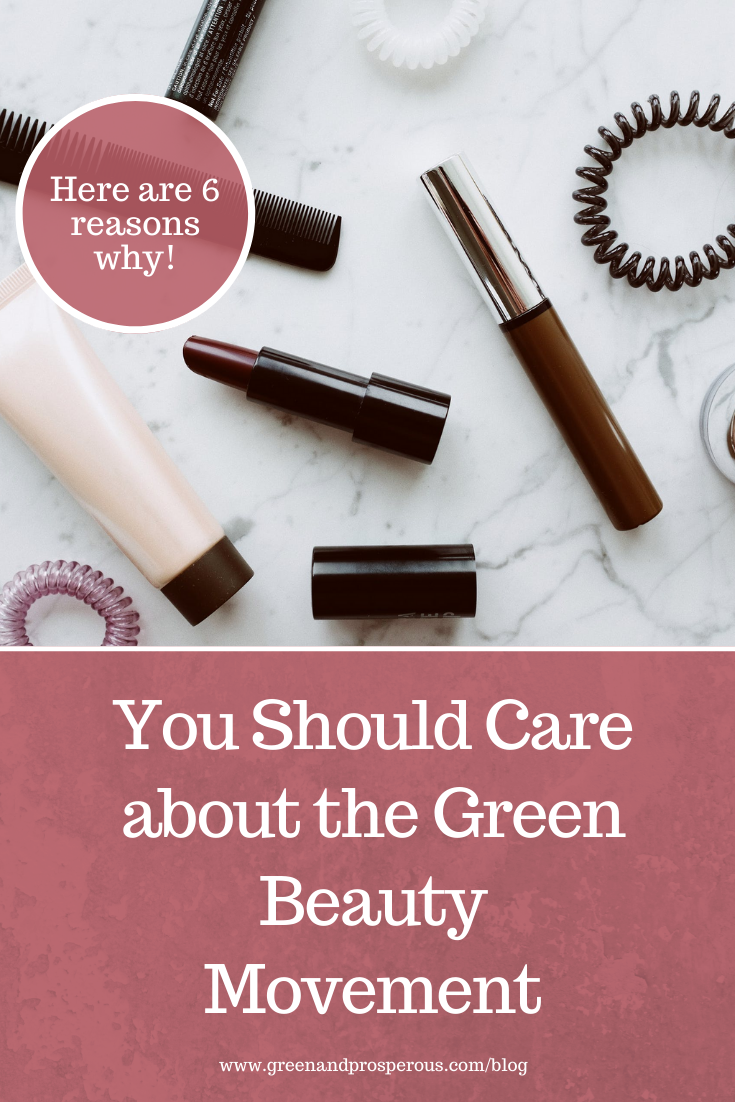6 Reasons Why You Should Care about the Green Beauty Movement
/(2nd post in a 3-part series on green beauty)
As my previous post on the Green Beauty Movement mentioned, more people have become aware of the presence of harmful chemicals in many commercial personal care products. As a result of that growing awareness, as well as a general increase in public discussions about major climate-related and public health crises, there is more interest than ever in environmental issues. The Green Beauty Movement represents one small aspect of this phenomenon, but it is more important as a bellweather of healthy living trends than you might have realized. Here are six reasons why the Green Beauty Movement matters for the collective, global push towards a greener environment and a healthier you.
Photo via Visual hunt
1. Because there is a direct connection between the products you use and the health issues you are dealing with. Many people don’t think about what might be in the toothpaste, shampoo, deodorant, lotion, soap, or makeup they use, but most commercial brands contain chemicals that have been linked with negative health outcomes ranging from ones that are mildly inconvenient (e.g. skin irritation) or life-threatening (e.g. cancer). Companies selling these products, as well as government regulatory bodies, usually claim that the amount of potentially harmful chemicals in them is miniscule and not much of a threat to human health. That is largely true, except if you think about the fact that you are using these products every day, multiple times a day, and are being exposed on a constant basis to harmful chemicals that may be behind some of the health issues you and/or your family members have been facing. Most studies and reports that downplay the harm caused by chemicals like parabens or ureas don’t take this into consideration. Instead, clinical studies tend to focus on a single instance of exposure in a controlled environment. If you are pregnant, the ingredients in the personal care products you use are entering your baby’s bloodstream through the placenta, and their little bodies are not equipped to excrete (flush out) these chemicals adequately.
2. Because the US government does not really regulate what goes into your cosmetics or other personal care products. The FDA is responsible for guaranteeing the safety of cosmetics by enforcing the Federal Food, Drug, and Cosmetics Act (FD&C Act), while the EPA is in charge of regulating pesticides and toxic substances under the FD&C Act and the Toxic Substances Control Act. Back in 2015, the EPA and FDA signed a memorandum of understanding (MoU) for sharing data on pesticides and toxic chemicals, which was intended to enable them to better assess risks to the public and the environment. However, despite these responsibilities, the FDA and EPA have been unable to carry out their responsibilities effectively, in part because of the high number of potentially dangerous chemicals that enter the market each year, in part because of effective lobbying and obfuscating by the chemical industry, and in part because of staff shortages and budget cuts in these agencies. Under the Trump administration, regulatory bodies like the EPA and FDA have been further hobbled in their ability to regulate industry’s use of harmful chemicals in commercial industrial and consumer products. A study by Northwestern University shows that consumer complaints about harmful chemicals in cosmetic products more than doubled from 2015-2016, but the EPA has largely ignored these complaints. What’s more, cosmetics companies are not required by law to report complaints about their products to the FDA or any other regulatory body.
3. Because it demonstrates the power of consumers to change manufacturing practices that harm us. The bottom line: you as a consumer have to take matters into your own hands. Is it fair that you have to virtually get a degree in chemistry to understand whether the products you are using may cause your health to suffer? Absolutely not! But the fact is, it’s going to be up to you to do the work if you want to know more. Fortunately, two things are making it easier for you to become better informed. One, more people are demanding toxin-free beauty products, and you don’t need an MBA to figure out that consumer demand drives production. There are many green beauty products and companies out there working hard to bring you eco-friendly, effective products. But caveat emptor: as more companies get into the green beauty game, that means more companies will also engage in greenwashing to convince you to buy their brand. How can you avoid falling for the eco-friendly hype? That brings us to the second thing that’s making it easier for you to become informed: activists and others out there are giving you the tools, tips, lists, and apps you need to make more informed decisions. One great tool? Our toxic chemical cheat sheet. It’s one of the tools available when you sign up for the free resources library on the Green and Prosperous website.
4. Because it is helping raise awareness about the prevalence of toxic chemicals in personal care products. While most millennials have been trending towards healthy living for a while now, with American youth in their 20s and younger being way more concerned about GMOs, organic food, and green living than other groups, the rise in interest and awareness about harmful chemicals in personal care products and other consumables cuts across boundaries of class, ethnicity, age, income, and geographic location. By some accounts, the health and wellness industry is set to become the next trillion dollar industry, with environmentally friendly beauty and anti-aging products topping the list of most sought-after consumables.
Photo credit: classic_film via VisualHunt / CC BY-NC
5. Because the more people become interested in green beauty, the more companies will offer these products, driving competition and (ultimately) increasing affordability. It’s no secret that many organic or otherwise eco-friendly beauty products don’t come cheap. Toxin-free nail polishes tend to start around $9 a bottle, and organic anti-aging skin creams can easily run into the hundreds of dollars. A few companies offer products that are lower-priced and more affordable, but none (at least as far as I know) has been making products for low-income or poor people, who disproportionately suffer the consequences of exposure to harmful chemicals in the environment and in the products they use. Want to make the switch but don’t want to break the bank? Check out these products by Dr. Bronner. They make more than just soap, and are currently offering a monthly special of 15% off! Alba Botanica, Desert Essence, Güd, and Kiss My Face also make great eco-friendly and budget-friendly products.
6. Because the more you care about green beauty, the harder green beauty companies will work to ensure that their products meet the highest standards for performance, sustainability, and authenticity. It’s no secret that even the most eco-conscious companies can make mistakes. That’s to say, in the best case scenario they are mistakes. Companies from Whole Foods’ 365 brand to Boots Retail USA have been sued for allowing harmful chemicals into some of their products. This brings me back to a point made in #3 of this list: the power of the consumer. The same is true for green beauty products as any other – ultimately consumers have the power to change manufacturing practices, and it’s often collectives of consumer groups that call companies to task if they have not lived up to the standards they profess. One of the most recent unfortunate examples has been the Honest Company, which settled a nationwide class-action lawsuit for $1.55 million over accusations that it misled consumers about ingredients in its laundry detergent and dish soap. Another example is Wen by Chaz Dean, the hair care products company owned by direct marketing pioneer Guthy Renker (which has been around since the late 1980s). A class-action lawsuit against Wen drew the attention of the FDA, which launched an investigation into the safety of its Cleansing Conditioners just last year. Other companies have taken note and are working overtime to ensure the safety and reliability of their products, in some cases taking on the manufacturing and sourcing of those products themselves.
Are you interested in making the switch to green beauty products? The last post in this series asks the experts to name their go-to products and tell you why they recommend them, so come back to find out more in a week!
Like this? Please pin!








































